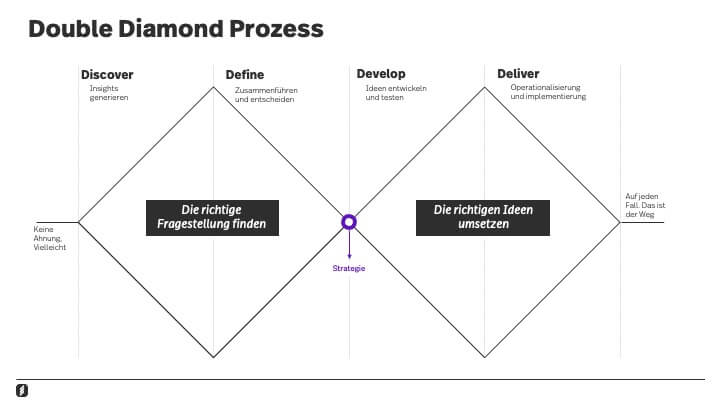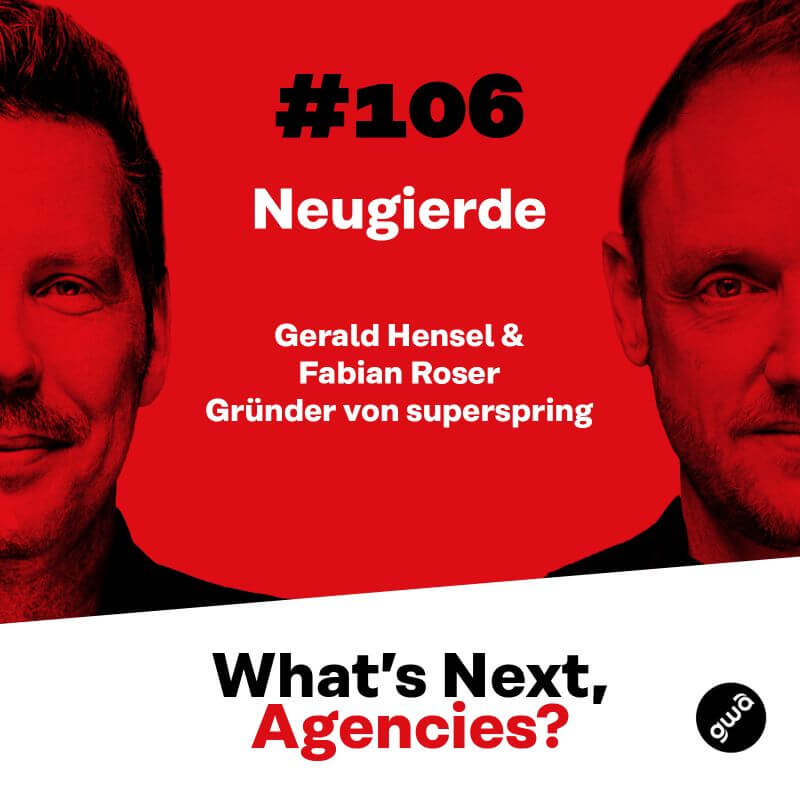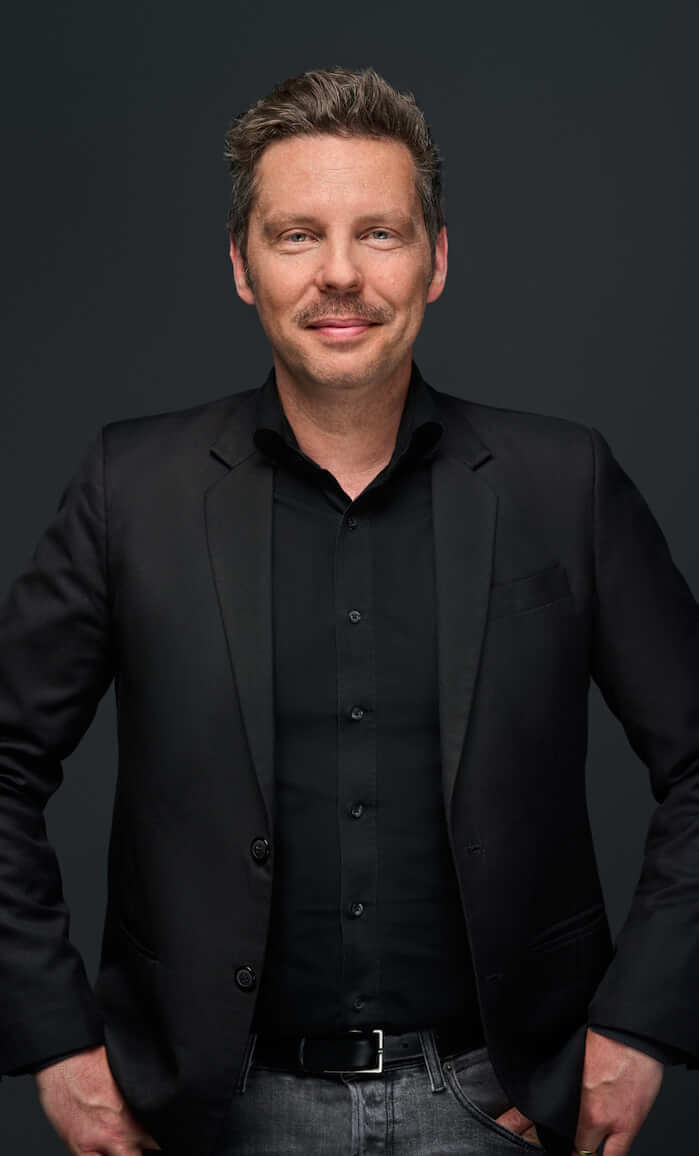In German, the word "curiosity" has never actually had a particularly positive connotation. In German, "Curiosity" is a compound word that combines the two words "new" and "greed" - not a particular nice word. Yet a healthy dose of curiosity is a basic prerequisite for understanding various problems and creating progress, especially in the marketing world. Productive curiosity is more endangered than ever, especially in our automated world. And this is precisely why curiosity needs to find a place in our processes again - because the alternative is copy-paste.
No, it's definitely not a good association that has been instilled in us since childhood, especially in German, with the word curiosity. If you google it, you come across a definition that is actually very unflattering. Curiosity is...
"the desire, wish to learn something [new], to penetrate into matters, areas that particularly affect other people and their private lives or similar..."
Neugierige Charaktere traten in unseren Geschichten früher immer wieder auf. Frühe Kindererzählungen, wie der Struwwelpeter sind gespickt mit teil brachialen Warnungen von Kindern, die zu neugierig sind und dann meistens auch noch deswegen scheitern. So Like the "Paulinchen"a girl who was "home alone" in an old German children's book story and then something bad happened to her: she set herself on fire. (yes, that's how German children's stories used to go).
Wherever we look, children in particular were taught curiosity as a boundary transgression: Curious characters were not usually super villains. Instead, they were usually portrayed as overbearing, unsympathetic types who stuck their noses too deeply into other people's topics.

Natürlich sind solche Metaphern immer ein Spiegel der Zeit, in der sie geschrieben wurden. Gerade Kinderliteratur im 19. Jahrhundert spiegelte auch das Erziehungsbild der autokratischen deutschen Gesellschaft damals wider. Neugierigen Kindern sollten schon früh Regeln mit an die Hand gegeben werden, die auch den „Untertanen“ später gut zupass kam. Wer nicht zu viele Fragen stellte und nicht zu viel wusste, konnte auch nicht zu viel Unheil anrichten.
Simple, isn't it?
Curiosity superpower?
But perhaps it's the supposedly small differences that separate the German "Neugier" from the English "Curiosity". After all, the latter doesn't just sound nicer. übergriffig klingt. Nein, diese Neugier entstammt einer ganz anderen Welt – eine, in der Ideen entstehen und Gedanken gesponnen werden dürfen. Die produktive Neugier kann Ideen destillieren und in umsetzbare, testbare Lösungen verwandeln helfen.
Keine Frage: Eigentlich ist eine gesunde Neugier die Basis-Voraussetzung für Innovation und sie öffnet die Tür für effektivere Wege vorwärts. Gerade im Marketing geht es gar nicht ohne. Kaum vorstellbar, dass man sich ohne diese Schlüsseleigenschaft in die vielfältigen Fragestellungen im Marketing einarbeiten kann. Briefings, Branding, Kreativ-Sprungbretter: Ohne produktive Neugier undenkbar. Und das findet langsam Anerkennung. Denn Richtig eingesetzt wird Neugier für Kollegen, Teams und die Organisation mittlerweile sogar als leadership superpower for colleagues, teams and the organisation that can develop when it meets a supportive corporate culture.
But does such a culture still exist today?
"You can only know a lot if you have an intrinsic curiosity within you."
– Fabian Roser in #WhatsNextAgencies
Doubts are indeed justified. The creative industries are more focussed on efficiency than ever before. The signs of the times are in favour of automation. More and more exploration has to be extremely targeted. Genuine research into what constitutes an issue is increasingly being replaced by quick copy-paste research that turns briefings into Jira tickets in the blink of an eye. UX designer Michal Malewicz describes this state of the creative industry in his article "Design has lost its seat at the table":„:
„The industry has matured. Most design solutions were discovered and are now simply duplicated. (…) We have extreme consistency at a cost of less insightful products being built. There is no time and no money to do things the old-fashioned way.“
We are currently experiencing this process of automation in all traditionally creative areas. Creativity has to fit more and more into formats and systems, which is due to the increasing mechanisation and software dependency in all areas. Does this impose limits on creativity or does it inspire it? And what role does curiosity play in this? On the face of it, the search for a different solution, the exploration of what has not yet been done, seems to be antithetical to the mechanisation of our time. Anyone who "spins" and thinks about completely different approaches is initially opposed to the efficient zeitgeist. Apparently.
superspring Notes:
Our newsletter about new marketing
The superspring newsletter with our look at what's coming in marketing - and, of course, what we contribute to it. Sent out regularly and can of course be cancelled at any time.
Nine characteristics of productive curiosity
Ohne Zweifel gibt uns eine automatisierte Welt neue Auflagen mit. Auch unsere Suche nach der besseren Lösung muss sich verändern. Neugierde muss produktiv sein, um eine Rolle in effizienten Businesses spielen zu können. Zum Glück entscheiden wir nicht selbst, ob wir neugierig sind oder nicht. Diese Eigenschaft ist uns in die Wiege gelegt. Und sie variiert in ihren Ausprägungen von Mensch zu Mensch.
The neuropsychologist Anne-Laure Le Cunff identifies nine characteristics that are typical of particularly productively curious people. Le Cunff's theses quickly reveal the value of productively curious people for organisations: They draw connecting threads between concepts that no one else can draw
What productively curious people do differently:
- They are looking for transitions and spaces in between. Curiosity is particularly productive in the sphere between the known and the unknown, between knowing and not knowing. Where the possible becomes the certain, curious people can develop new solutions and drive innovation forward.
- They spin connections between ideas. Networks replace linear thinking in their minds. Unexpected connections between two concepts are welcomed and further developed to - metaphorically speaking - make 1+1 more than the sum of its parts.
- They ask generative questions. They are not only interested in facts, but also in underlying feelings, motivations and the context of a situation. Content is scrutinised openly, multidimensionally and empathically because a problem needs to be understood from a wide variety of perspectives.
- They explore (sometimes too much). Naturally curious people tend to have many interests. Ideally, this can have an inspiring and exploratory effect (and create connections that no-one else can), but it also harbours the seeds of dissipation.
- They learn continuously and publicly. Those who see themselves as lifelong learners do not see "not knowing" as a problem, but only as the next task. Curious people rarely see themselves as real experts, but rather as people who may have reached a good intermediate level, but still have a lot to learn. Acquired knowledge is gladly shared.
- They challenge what is taken for granted. The status quo is seen by naturally curious people as a testable working hypothesis. Everything could be like this, but it could also be different. In this basic assumption of the world lies the idea that the status quo of the world can and must be scrutinised as a matter of course.
- They listen with empathy. Where curious people want to experience the world, empathy is naturally part of the information intake process. They can therefore only experience complex, multi-layered contexts if they have the necessary sensitivity in their communication.
- They can understand difficult experiences. Even supposedly bad experiences are a useful source of information for curious people. Curious people rarely ignore these contexts, but often question and reflect on them empathetically. Problems are part of life and are therefore accepted.
- They welcome the unexpected. For curious people, surfing the chaos is a normal part of their existence, as they see constant change and uncertainty as a normal state of the world. Chaotic times are good for these people because they learn a lot and create solutions from possibilities.

Does curiosity still have a role in an automated world?
Here at superspring, we firmly believe that productive curiosity matters more than ever. Whether you are working on a new Branding or on a new Communication Strategy Their interest in the next step creates the conditions under which progress can succeed.
But the combination of curiosity and creative realisation has also been reorganised. There is a new productive interplay between "intellectual spinning" and goal-orientated execution. This process needs to be understood by the creative industries and also thought of in practical processes. The good news is that business decision-makers can be more creative than ever.
Creatives were the monopolists of curiosity for years. They increasingly have to direct their creative energy in a targeted manner. Do you work on overarching, creative meta-concepts or do you primarily create content within the framework of systems? The skills of people who break down boundaries and rethink worlds are different to those who realise marketing and communication on a daily basis.
In this respect, curiosity also plays a different role depending on whether you see yourself more as an idea maker or a creative producer. Those who want to reinvent the world every day need different inspiration than those who want to innovate the latest possibilities in social media. And yes: this is often also a question of your own biography in a rapidly changing creative industry.
Business decision-makers (who may or may not be creative) are currently experiencing a creative renaissance in our opinion. For years, the combination of curiosity and creative power was reserved for "the creatives". Today, the process is increasingly becoming the main creative achievement. After all, anyone who can integrate a cascade of measures, KPIs, stakeholders, processes, messages and technologies into a briefing may well ask whether this is not already a very creative process.
In a world of creatively applicable technologies, content strategies and 24/7 innovation, thinking about complex, orchestrated marketing measures becomes a creative endeavour in itself - in real time. This is often a challenge for marketing decision-makers and their teams. After all, the multitude of possibilities today is overwhelming. Nobody can do and know everything. Rather, it is important to provide your own processes and your own level of knowledge with the support that creates results from ambiguity.
Does this mean that the ability and requirement for creative work has been reorganised? Are decision-makers the new creatives? Not necessarily. But we believe that creativity is more structured and focussed than it used to be. There is a broader and more nuanced concept of creativity. And that also applies to the role of curiosity. Loosely based on the Double Diamond strategic process model - which we also use - there are times for spinning and exploring. And there are times when we need to condense ideas and bring them to fruition. Only one thing is essential: you have to know when what is needed in the process.

How we make curiosity useful again
There is a reason why we, the founding team of superspring, have been working in advertising agencies, management consultancies, start-ups and now our own consultancy for decades: We are curious people. And we enjoy spending time with other curious people. And we believe that most people who are starting in this industry,harbour this desire for what could be.
In fact, we believe that inherent curiosity is one of the many reasons why the marketing bubble is still so interesting for so many people: those who work here need this desire to explore and understand new companies, industries and people, which is more pronounced here than anywhere else. The communications industry needs people who are searching for a deeper truth. Regardless of whether they find it in a content audit or a marketing analysis zu finden glaubt.
superspring channels curiosity for more productive processes.
superspring helps to channel curiosity and turn it back into a productive superpower for organisations and people. This applies to us as well as to the teams we work with. And we apply it above all to the processes we create. Four pillars of our own curiosity are conceptually at the centre of our work:
- superspring practices radical collaboration with customers and partners.
The formula is simple: our customers are the experts in their business. We ask questions, structure and inspire. Our recipe is therefore radical collaboration. We involve customers and partners in a collaborative process right from the start in order to dovetail the most productive elements in a meaningful and creative way: Expertise, inspiration and an outside perspective.
- superspring channels curiosity in marketing innovation processes
The pressure of constant innovation drives us all. It's not just about nice working hypotheses for a better world, but about concrete, realisable innovations. That's why we organise innovation circles for customers that channel curiosity and turn it into projects. The aim: to transfer structured inspiration into the next product, the next campaign idea, the next service.
- superspring connects players who would otherwise not co-operate. Every person who is productively involved in a process changes an equation and therefore the result. As a strategy and orchestration partner, we often bring partners together who would otherwise rarely co-operate. SEO meets brand design? CRM meets media? If cooperation is conceivable in a process, we try to explore it.
- superspring macht Wissen siloübergreifend nutzbar. Last but not least - even after many, many customers, we get to know a new industry with every project. Marketing silos usually form automatically in the short term for reasons of efficiency. They can be broken by transferring conventions from one world to the next. By letting industries learn from each other and making best cases usable across the board, we break the cycle of constantly creating new silos.
Anyone who finds the question of how curiosity can be productively organised so exciting. Among other things, we recently gave the #WhatsNextAgencies Podcast by Kim Notz and answer questions. Number 106, with superspring co-founders Gerald Hensel and Fabian Roser, is all about this: What does curiosity bring us? And why is it sometimes good to be a little naive?
🎧 You can listen to the episode here: To episode 106.

What’s Next Agencies ist der Podcast über die Zukunft der Agenturbranche. KNSK CEO Kim Notz befragt dabei alle paar Wochen Entscheider:innen rund um ihre Geschäftsmodelle und ihren Blick auf die Zukunft der Agenturbranche.
Picture credits
- Bilder von Midjourney
- Vorschaubilder von KNSK / WhatsNextAgencies



